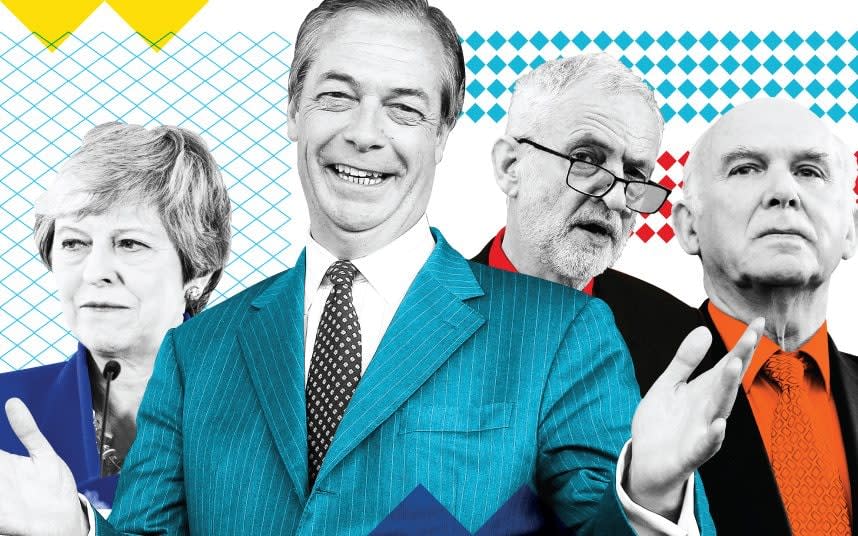EU election results analysis: How the Brexit Party won the most UK seats

Nigel Farage's Brexit Party has won the most UK seats in the European elections, with 28 of their candidates elected across the country compared to Labour's 10 and the Tories' three.
Just under a third of voters backed the Brexit Party while the Conservatives slumped to their lowest share of the vote ever in a national ballot.
This pattern fits into a continent-wide trend of traditionally large parties taking a hit, with smaller outfits gaining support.
It has resulted in the two large establishment blocs in the European Parliament losing their combined majority under rising populist and liberal support.
Labour, as well as the Conservatives, lost ground with the pro-Remain Lib Dems and Greens picking up seats alongside the pro-Brexit Brexit Party. The Lib Dems ended up in second place in the UK, while the Greens managed to top the Conservatives nationally.

The Brexit Party gained seats across the country
So far, with only Scotland and Northern Ireland yet to declare, the Brexit Party have secured a seat in every region of the UK.
Mr Farage's party secured over 35 per cent of the vote in every region but London, the North West and Wales, with its best showing in the North East, where it picked up 38.7 per cent of the vote.
This compares to the Lib Dems, Greens and Change UK, who collectively failed to win seats in Wales and the North West.
Of the Remain-backing parties, Change UK received by far the worst results, failing to win a single seat.

Farage beat his 2014 level
Nigel Farage's attempt to win the 2019 European election surpassed his 2014 attempt with Ukip, which is impressive considering the fact that the Brexit Party is only six weeks old.
In 2014, Ukip won the European election with 27.5 per cent of the vote. Farage built on this this time round, securing 33.3 per cent of the national vote and 28 seats - four more than his tally five years ago.
The rise of the Brexit Party in the polls was significant, going from around 10 per cent of the vote 40 days ago, to over 30 per cent today.

Brexit parties were out-polled those backing Remain
The only concern for Mr Farage's party will be the the fact that straightforwardly pro-Brexit parties were out-polled by those who are arguing for a second referendum and a halt to Brexit.
The Lib Dems, Greens, Plaid and Change UK - all backers of a second referendum - collectively gained the support of 40.3 per cent of the public in England and Wales, against no-dealers Ukip and the Brexit Party's collective 36.7 per cent.
These policies commanded 77 per cent of the vote, against the 23 per cent of the pro-compromise parties of Labour and the Conservatives.

As predicted, the lack of a Remain alliance - with the Lib Dems, Greens and Change UK all competing and splitting the pro-European vote - made their job of converting votes into seats even harder.
With the vote being read as a proxy for a second referendum, Nigel Farage's does-what-it-says-on-the-tin Brexit Party managed to unite the pro-Brexit vote under one banner, which helped him under the voting system used in the EU election.
The D'Hondt system is a list system of voting where multiple MEPs are elected per constituency after each voter has cast a single vote for a party (rather than a specific candidate). The vote share from these party level votes is then used to determine how many MEPs are elected from each party. Our interactive explainer, below, explains how it all works.

Brexit debate fires increase in EU election turnout
Early indications are that UK turnout in the European election is at its highest level since 2004 - although admittedly this was a low bar to surpass.
The previous high for European election turnout in the UK was just 38.5 per cent, hit in 2004.
With two regions yet to declare, turnout in England and Wales is estimated at 36.5 per cent - an increase of almost one percentage point on 2014.
Turnout across Europe increased significantly, to its highest level for 20 years at 51 per cent. The increased enthusiasm was seen by some commentators as a response to challenges ranging from climate change to the rise of eurosceptic parties.

In the rest of the EU, establishment parties suffered
At a continent level, the European Union's established centre-Left and centre-Right blocs were forecast to lose their combined majority in the elections.
The latest polls indicate that the two large pan-European blocs, the EPP and the S&D, will lose seats under a tide of both populist and liberal support. Respectively, they won 221 and 191 seats in the 2014 election.

The loss of their combined majority is likely going to be because of the rise of the liberal Alliance of Liberals and Democrats for Europe (ALDE) and eurosceptic Europe of Nations and Freedom (ENF).
These parties are currently forecast to pick up an extra 37 and 34 seats, respectively.
The latter of these blocs, the populist-Right ENF, is likely to morph into a new group called European Alliance of People and Nations after the election, under Italian Deputy Prime Minister Matteo Salvini.
The ALDE and ENF are forecast to make the largest gains in the election, leading experts to warn that the new Parliament could be more fractious with majorities harder to come by.

 Yahoo News
Yahoo News 
